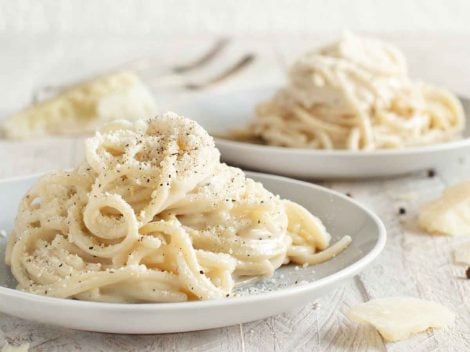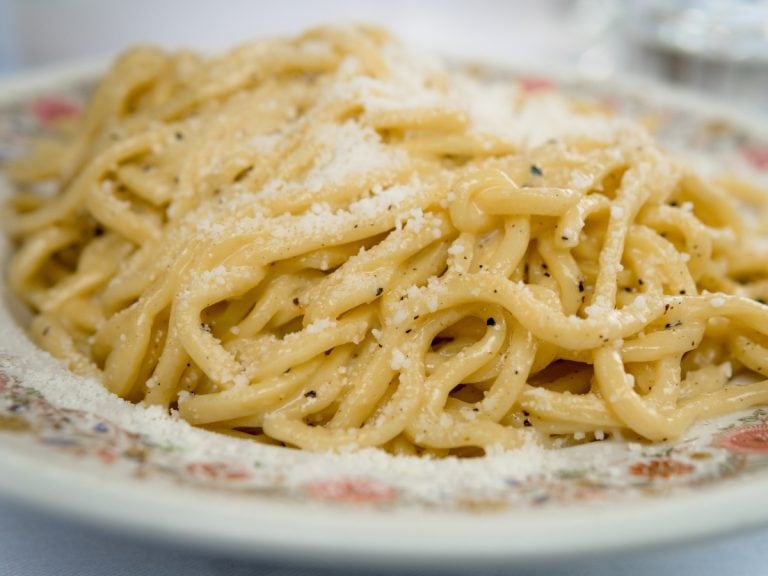"It is more difficult to make scientific cacio e pepe than carbonara," Dario Bressanini begins, smiling, when we ask him to give us the "reasoned" recipe for cacio e pepe using scientific methods. After the success of his scientific carbonara honed over the years, we delved into his recipe books to uncover the tricks and secrets of one of Rome's quintessential dishes.
Cacio e Pepe: the secret of creaminess and the using the right cheese

Usually, the widely known method involves draining the pasta and quickly mixing it with grated pecorino and a sprinkle of pepper. Some add cooking water while stirring, aiming to create a velvety cream, but often the result is a watery mixture full of lumps or cheese threads that even Parmigiano can't achieve. The ingredients are not wrong, but the procedure is crucial.
"The fundamental point is to prepare the cream, and it is mandatory to prepare it separately because you have to melt the cheese without creating lumps," explains Bressanini. Pecorino is the protagonist of this recipe and, compared to Parmigiano, is more challenging to work with: "because it all depends on the degree of ageing," specifies the scientist. "it depends on how aged the pecorino is: if it is too fresh, it means it still contains too much moisture," and the skill lies in balancing the added pasta cooking water when melting the cheese in a double boiler.
As Bressanini explains, cheeses have a protein tissue that retains water and fats. The percentage of these elements determines the cheeses' ability to melt better, or more slowly. Aged cheeses, which contain a lower percentage of moisture, tend to melt more slowly because protein bonds require higher temperatures to break. However, attention must also be paid to the temperature because if it is too high, it creates lumps.
How to make scientific Cacio e Pepe
It is not necessarily true that less means simple. Even though the list of ingredients for cacio e pepe are only three (pasta, pecorino romano, and pepper), making this recipe requires a lot of attention and lots of experimenting, as Bressanini says, "science proceeds through experiments."
The proportions for the scientific cacio e pepe cream are 20-25 grams of water for every 20 grams of pecorino. For a 100 g portion of pasta, you can use 30 g of pecorino. The process is simple; it's the cheese that is complex: "The easiest thing to do is to take a bowl with some boiling water, place it in a double boiler, add the pecorino, and melt it slowly until you get the cream, optionally adding a bit of starch to prevent lumps," explains Bressanini.
Meanwhile, the pasta cooks. Once al dente, drain the pasta, place it in a bowl, and add the cream. Mix and dust with fragrant black pepper.


 Farewell cacio e pepe in New York. "With tariffs, Pecorino Romano will also become more expensive." The warning from Giuseppe Di Martino
Farewell cacio e pepe in New York. "With tariffs, Pecorino Romano will also become more expensive." The warning from Giuseppe Di Martino Against tariffs? Here are the US foods that could be "hit"
Against tariffs? Here are the US foods that could be "hit" US tariffs: here are the Italian wines most at risk, from Pinot Grigio to Chianti Classico
US tariffs: here are the Italian wines most at risk, from Pinot Grigio to Chianti Classico "With U.S. tariffs, buffalo mozzarella will cost almost double. We're ruined." The outburst of an Italian chef in Miami
"With U.S. tariffs, buffalo mozzarella will cost almost double. We're ruined." The outburst of an Italian chef in Miami "With US tariffs, extremely high risk for Italian wine: strike deals with buyers immediately to absorb extra costs." UIV’s proposal
"With US tariffs, extremely high risk for Italian wine: strike deals with buyers immediately to absorb extra costs." UIV’s proposal






